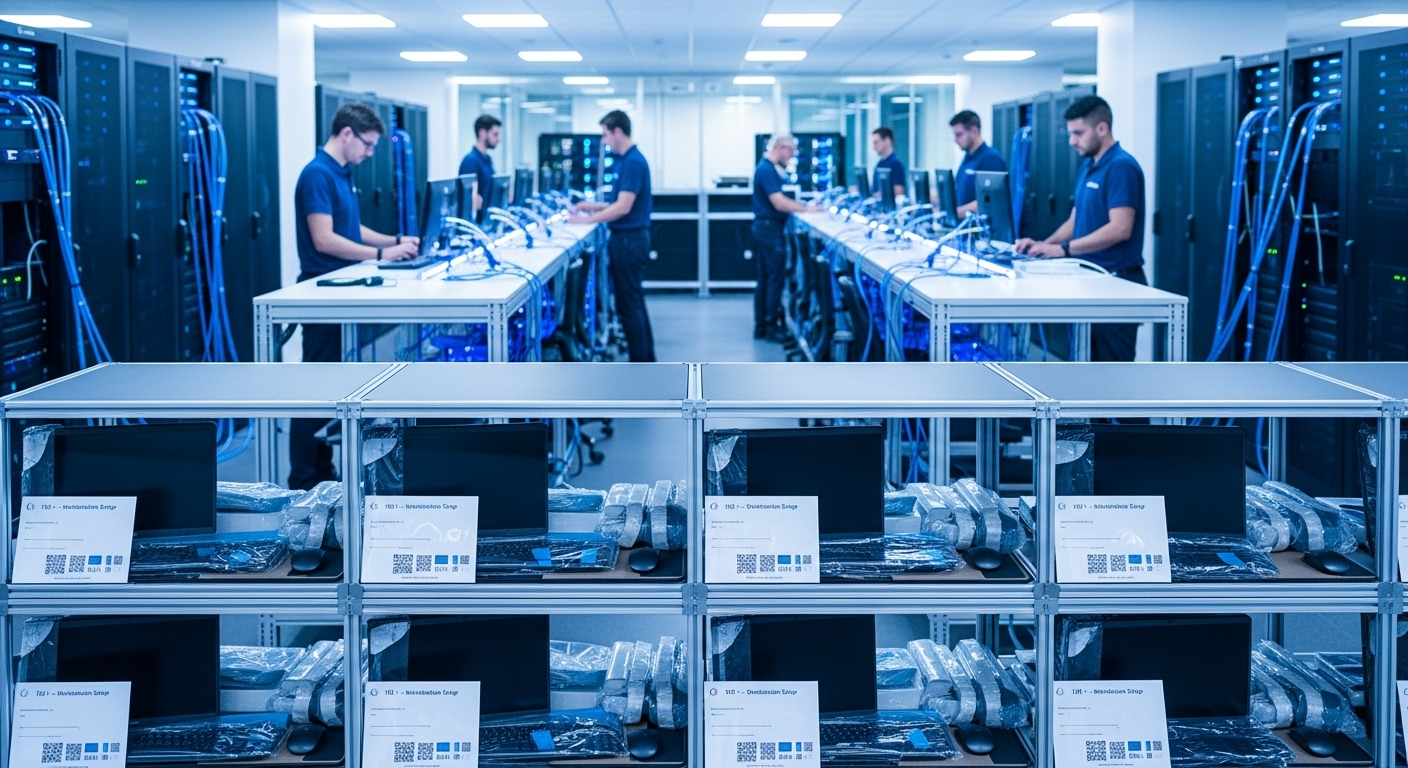Launching a new office is an exhilarating milestone, but the path to opening day is paved with complex logistical challenges, none more critical than the IT setup. In a thriving business hub, a flawless technological launch isn’t just an advantage; it’s a necessity. Too often, IT is treated as a final checklist item, leading to costly delays, security vulnerabilities, and day-one frustrations that cripple productivity before it even begins. This guide moves beyond simply unboxing hardware. We will dissect the intricate logistics of designing and deploying a robust IT infrastructure, from initial blueprint to final execution. We’ll explore strategic planning, vendor coordination, and security protocols that ensure your new office operates seamlessly from the moment you open the doors. For businesses aiming to make their mark, a well-orchestrated IT setup is the silent engine of growth, providing the stability and power needed to compete and succeed.
The pre-move audit: charting your digital course
Before a single cable is run or a server is ordered, the most crucial phase of your IT setup begins: the strategic audit. This foundational step is about looking beyond your immediate needs to architect an infrastructure that supports your long-term vision. Start by engaging key stakeholders from every department. What are their daily workflows? Which applications are mission-critical? What are their biggest technological pain points in the current setup? This isn’t just a technical inventory; it’s an operational discovery process. Document everything, from the number of required network ports per employee to the bandwidth demands of your most data-intensive tasks. Consider your growth trajectory for the next three to five years. Will you be hiring aggressively? Expanding into new services? Your IT infrastructure must be scalable to accommodate this growth without requiring a costly overhaul down the line. This audit should produce a detailed requirements document that will serve as the blueprint for every subsequent decision, from network design to hardware procurement. It’s the difference between building a system that merely functions and one that actively accelerates your business goals.
Designing the digital nervous system: cabling and connectivity
The unseen network of cables and wireless signals forms the central nervous system of your office. Getting this right is non-negotiable. The process starts with structured cabling—a methodical approach to wiring for data, voice, and video. Plan for more capacity than you currently need; running extra Cat6a or fiber optic cable during construction is far cheaper than opening up walls later. Work closely with your architect and a low-voltage electrician to map out data port locations, server room specifications, and Wi-Fi access point placements. A well-designed server room or IT closet includes dedicated cooling, sufficient power, and physical security. For wireless connectivity, a professional Wi-Fi heat map analysis is essential to identify potential dead zones and ensure seamless coverage across the entire floor plan. Finally, selecting the right Internet Service Provider (ISP) is paramount. In a competitive market like Burnaby, research providers that offer business-grade fiber optic connections with strong Service Level Agreements (SLAs) for uptime and support. A redundant or backup internet connection should also be considered to guarantee 100% uptime for critical operations.
The procurement puzzle: sourcing hardware and software strategically
Once your infrastructure blueprint is set, the focus shifts to procurement. This is a logistical puzzle where timing and relationships are everything. Begin by standardizing your hardware. Choosing specific models for laptops, desktops, and peripherals simplifies deployment, management, and maintenance. Instead of purchasing reactively, develop a strategic sourcing plan. Engage with multiple vendors to compare pricing and support packages. Consider the benefits of leasing versus purchasing equipment; leasing can offer lower upfront costs and easier refresh cycles, which is ideal for rapidly evolving tech. Software licensing also requires careful management to ensure compliance and cost-effectiveness. The most critical element, however, is the timeline. Lead times for specific server components, networking gear, and even laptops can be weeks or months. Order critical infrastructure hardware as early as possible to avoid a situation where your office is ready but your technology isn’t. Create a master procurement schedule with dependencies mapped out, ensuring every piece of the puzzle arrives exactly when it’s needed for installation.
Cloud vs. on-premise: making the right infrastructure choice
One of the most significant strategic decisions you’ll make is where your data and applications will live. The choice between on-premise servers, a full cloud migration, or a hybrid model has profound implications for cost, security, scalability, and maintenance. An on-premise solution offers granular control over your data and hardware but requires significant capital investment in servers, cooling, and power, not to mention the need for dedicated IT staff for maintenance. A full cloud model, using services like AWS or Azure, converts capital expenditures into operating expenses, offers near-infinite scalability, and offloads hardware management. However, it can lead to high recurring costs and potential data sovereignty concerns. The hybrid approach often provides the best of both worlds, keeping sensitive data on-site while leveraging the cloud’s flexibility for applications and collaboration tools. The right choice depends on your industry’s regulatory requirements, your team’s technical expertise, and your projected growth. For many businesses establishing a presence in Burnaby, a hybrid strategy offers an agile and secure foundation fit for a dynamic market.
The human element: vendor management and team coordination
Technology doesn’t implement itself. A flawless IT launch is a feat of human coordination, requiring meticulous management of multiple vendors and internal teams. You will likely be juggling relationships with your ISP, low-voltage electricians, IT hardware suppliers, software vendors, and potentially a managed IT services provider (MSP). Designate a single internal project manager to be the central point of communication. This individual will be responsible for scheduling site access, resolving conflicts, and ensuring each vendor meets their deadlines. Establish a regular cadence of meetings with all parties to review progress and proactively address potential roadblocks. Clear communication is essential. For example, the IT team needs to provide the construction team with the exact specifications for the server room’s power and cooling long before the drywall goes up. Internally, keep all departments informed of the timeline and what to expect on day one. A well-managed project prevents the finger-pointing and last-minute chaos that can derail an otherwise well-planned IT setup. It transforms a collection of contractors into a cohesive team working toward a single, successful launch.
Security from day one: building your digital fortress
In today’s threat landscape, cybersecurity cannot be an afterthought; it must be woven into the fabric of your IT infrastructure from the very beginning. During the setup phase, you have a unique opportunity to build a secure foundation rather than trying to patch vulnerabilities later. This starts with the network hardware itself. Configure your firewall with robust access control lists (ACLs) and intrusion prevention systems before it even goes live. Segment your network to isolate guest Wi-Fi from the internal corporate network, and further segment sensitive departments like finance or HR. Implement strong password policies and multi-factor authentication (MFA) across all systems as a baseline. Physical security is just as important. Your server room or IT closet should be locked, with access restricted to authorized personnel. Furthermore, establish a comprehensive data backup and disaster recovery plan. Regular, automated backups—following the 3-2-1 rule (three copies, two different media, one off-site)—are your ultimate safety net against hardware failure, cyberattacks, or natural disasters. By prioritizing security during the build-out, you create a resilient and defensible environment from the moment your team logs on for the first time.
The final mile: deployment, testing, and the go-live checklist
The final phase is where your meticulous planning materializes. This is the physical deployment and rigorous testing that ensures a seamless transition. Begin by setting up a staging area to unbox, image, and configure all workstations before moving them to their final desks. This controlled environment makes troubleshooting far more efficient. Once the core network infrastructure is in place, conduct thorough testing. Verify that every data port is active and performing at the expected speed. Test Wi-Fi signal strength in every corner of the office. Confirm internet connectivity and run speed tests to ensure your ISP is delivering on its promise. Before opening day, create a comprehensive go-live checklist. This document should include everything from verifying that employees can log in and access critical files to ensuring printers are mapped correctly. For businesses launching in Burnaby, a successful day-one experience sets a positive tone for the future. Consider a phased go-live or having IT support on-site for the first few days to quickly address any minor issues that arise. This final-mile diligence is what turns a good plan into a truly flawless launch.
Ultimately, a new office IT setup is far more than a technical project; it’s a strategic investment in your company’s future productivity and security. By moving beyond a simple checklist and embracing a holistic, logistical approach, you can mitigate risks and build a technological foundation that not only works but excels. From the deep discovery of the pre-move audit to the rigorous testing of the final mile, every step is an opportunity to align your technology with your business objectives. This meticulous planning ensures that on day one, your team isn’t battling connectivity issues or hunting for files; they’re focused, productive, and empowered by the very systems designed to support them. A flawless launch isn’t about luck; it’s the direct result of strategic foresight and disciplined execution. By mastering these logistical complexities, you are not just opening an office—you are launching an engine for sustained growth and innovation.





